Acne is common—and not just on your face. Dermatologists explain how to get rid of chest acne and keep it from coming back.
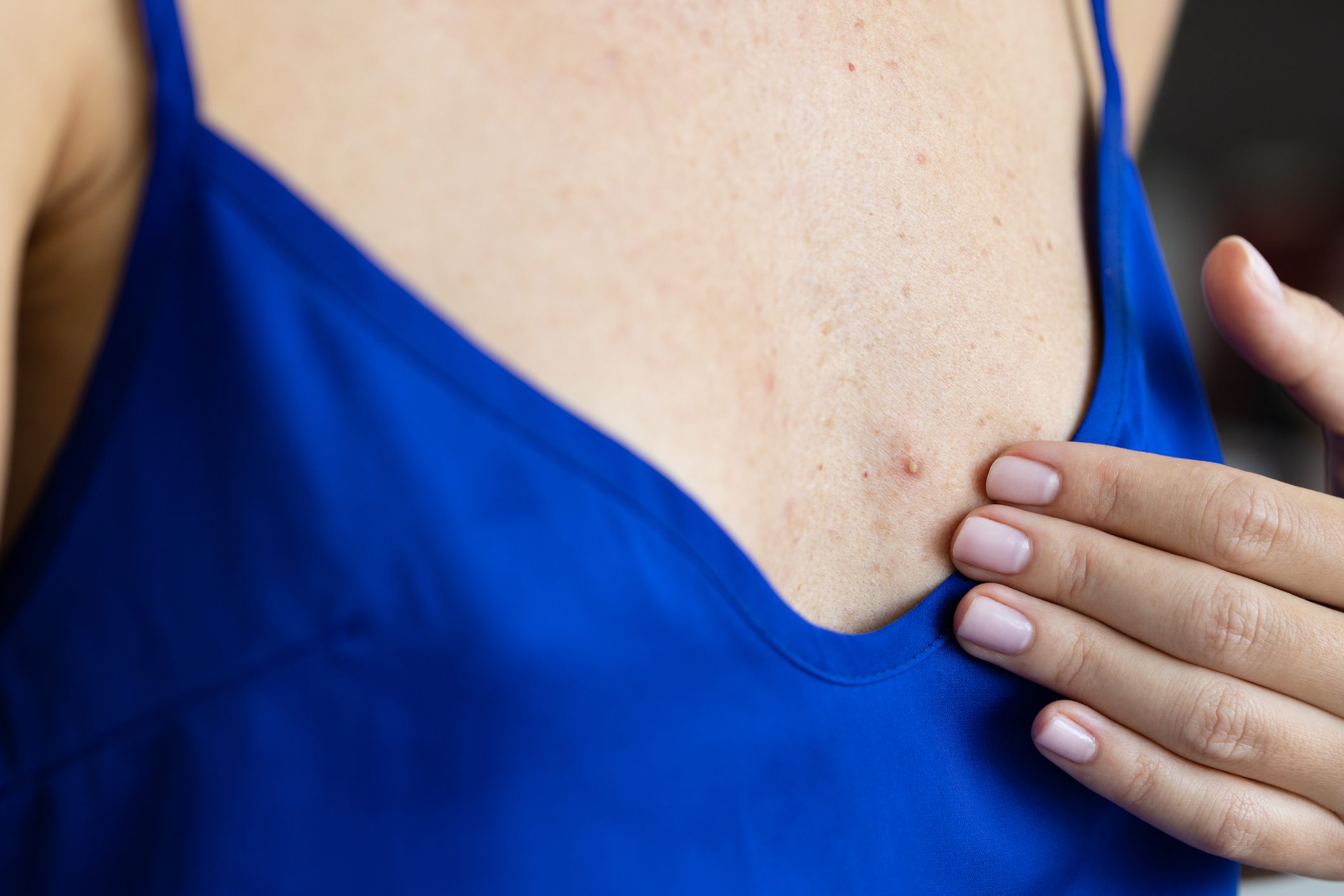
11 Ways to Get Rid of Chest Acne for Good, According to Dermatologists

About the experts
|
Highlights
|
If you want to learn how to get rid of chest acne, know that it isn’t necessarily the same as treating pimples on your face, according to 2022 research published in the Journal of Clinical Medicine. No matter where it occurs on your body, acne develops when your pores get clogged. There are many reasons this can happen—and if you’re prone to facial acne, you’re more likely to get pimples popping up on your chest, too. But the research says that, while there are some shared characteristics between facial and chest acne, there are also notable differences in how chest acne can form.
“The more precise term for chest acne is folliculitis,” says Susan Massick, MD, a dermatologist at The Ohio State University Wexner Medical Center. The mechanisms are similar to facial acne, she says, but on the chest, the hair follicles themselves can become more easily clogged with oil (natural sebum) and exacerbated by bacteria on the skin—resulting in larger, inflammatory papules or what’s called nodulocystic lesions.

What chest acne looks like
“Chest acne will look much like acne on any other area of the body—face, back, buttocks, et cetera,” Dr. Massick says. “And breakouts can range in appearance from the small blackheads or whiteheads (comedones), the more inflammatory red papules or pustules, and the deeper, more painful nodules and cysts.”
Victoria Billero, MD, MS, FAAD, a dermatologist at Tufts Medical Center, explains that chest acne can be classified into a few different categories. “And yes, people can experience different types of acne at once.”
She says that the types of acne most commonly seen in the chest area include:
Inflammatory acne
Inflammatory acne presents as red, swollen, and sometimes painful pimples. As these pimples contain pus, there’s often a yellow or white “head” at the center. Cystic acne is one type of inflammatory acne.
Comedonal acne
Comedonal acne includes blackheads (open comedones) and whiteheads (closed comedones)—but they’re not red, inflamed, or painful. These look like little bumps that don’t contain pus.
Hormonal acne
Hormonal acne is classified by the cause—hormones—not necessarily the appearance. It occurs due to an overproduction of sebum, which clogs pores and can result in inflammatory pimples, comedonal blackheads or whiteheads, or deep, painful cysts, per the Cleveland Clinic.
Fungal acne
Fungal acne is actually an infection in the hair follicles, which causes clusters of red, itchy, pimple-looking bumps. It often looks the same as inflammatory acne—the main difference (other than the cause) is that fungal acne tends to cause itchiness.
In addition, Dr. Billero says, “There’s something called ‘pityrosporum folliculitis,’ which is a form of acne that we describe as ‘monomorphic papules and pustules,’ which just means all the lesions are very uniform in appearance.”
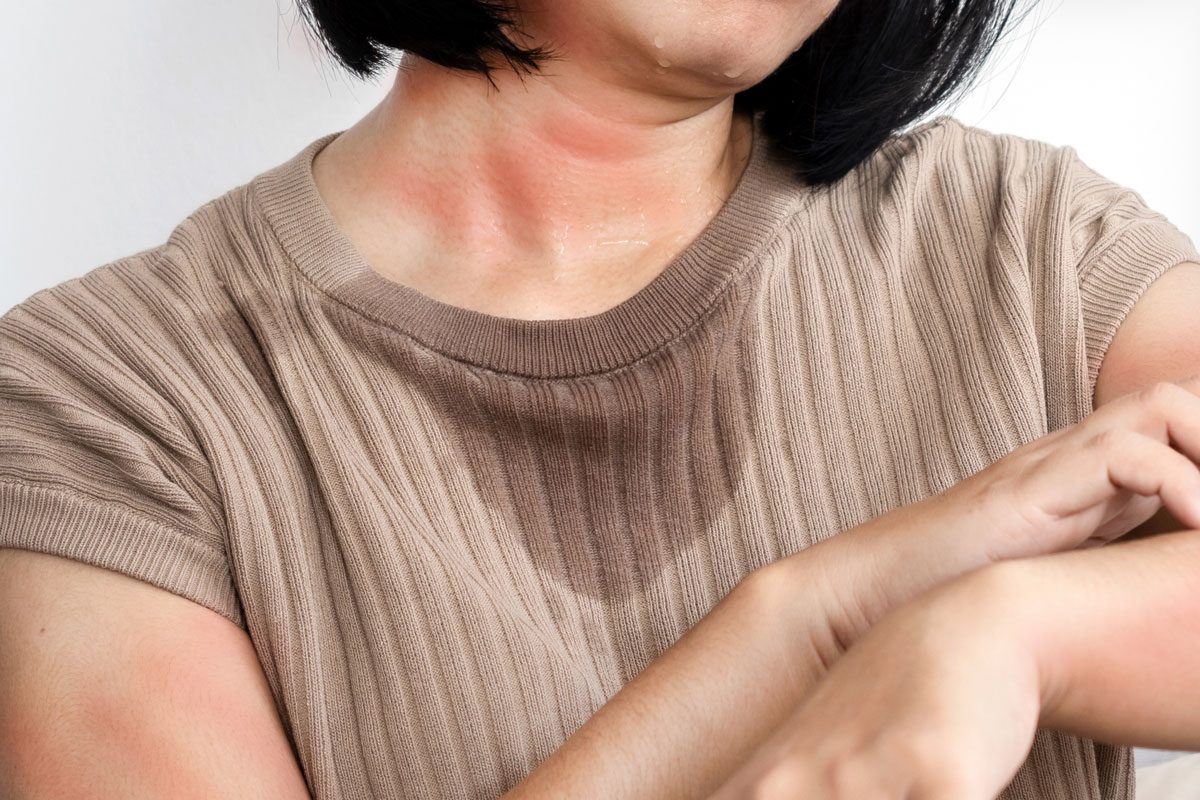
Causes of chest acne
While the exact cause of chest acne is the same as acne anywhere else—clogged pores—characteristics of the chest skin can influence how chest acne develops.
For instance, the skin on the chest differs in thickness, pH level, distribution of the sebaceous (sebum-producing) glands, and the amount of sebum produced compared to other areas, such as the face, according to the Journal of Clinical Medicine research.
The research also explains that chest-area skin is more vulnerable to things like friction, sweat, oils, pressure, and occlusion. Occlusion means blocking the pores, Dr. Billero says. “A common scenario is wearing tight clothing during exercise, which causes bacteria, sweat, and oil to clog the pores, leading to the development of acne.”
In addition to tight, sweaty exercise attire, Dr. Billero and Dr. Massick say that common causes of chest acne can include:
- Occlusion from compressive clothing
- Skin or hair care products that block the pores
- Not washing the skin regularly to remove sweat, bacteria, dirt, and oil
- Dietary factors
- Certain supplements
- Some medications
- Stress
- Hormonal changes, particularly during puberty or pregnancy
“Additionally, genetics plays a big part as well,” Dr. Billero says.
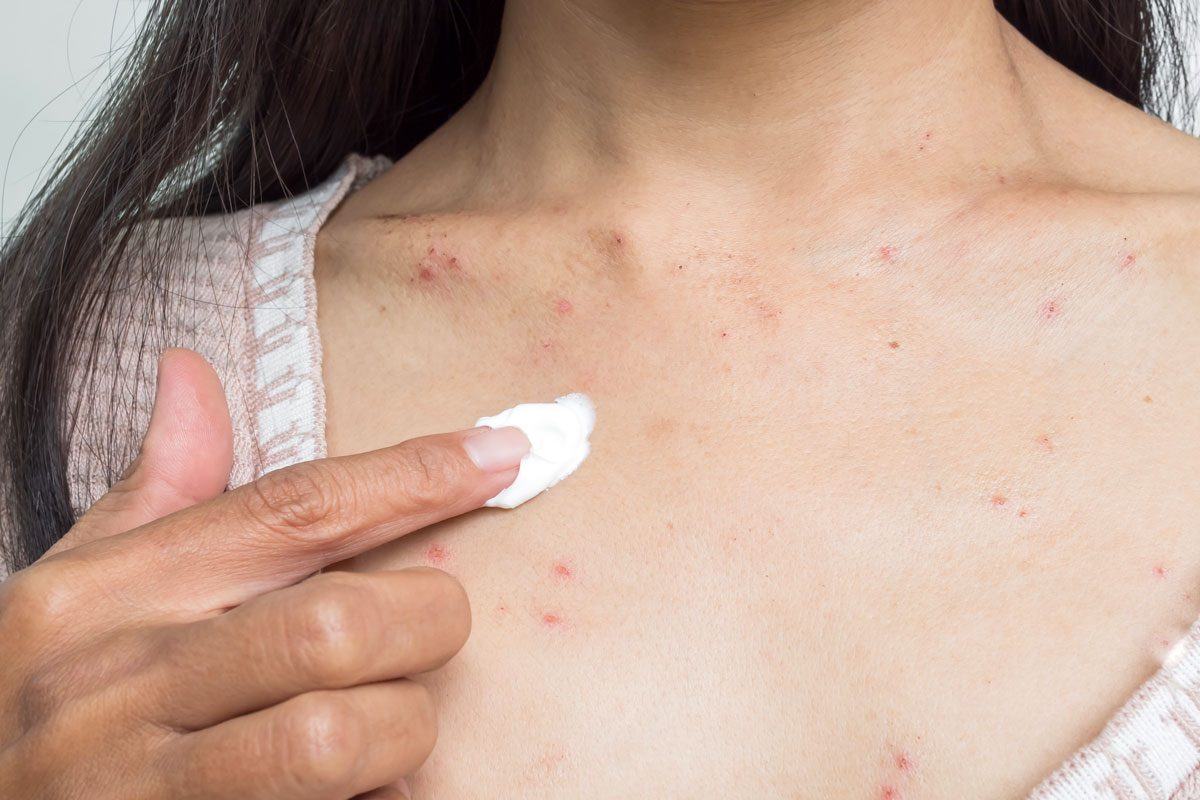
How to get rid of chest acne
“Although there is no cure for acne, there are many effective treatments available,” Dr. Massick says. But keep in mind that everyone is different, and the right fix can depend on the cause of your chest acne and what type you’re dealing with.
Simple changes, such as product swaps, may benefit some people—while others might see acne improvement through lifestyle changes, help from a dermatologist, or some combination of approaches. So, getting rid of your chest acne may take some trial and error.
“Some people like to try things at home first but others prefer to see a doctor from the beginning,” as a dermatologist can correctly diagnose the type of acne and help pinpoint lifestyle factors or other issues contributing to your acne, Dr. Billero says.
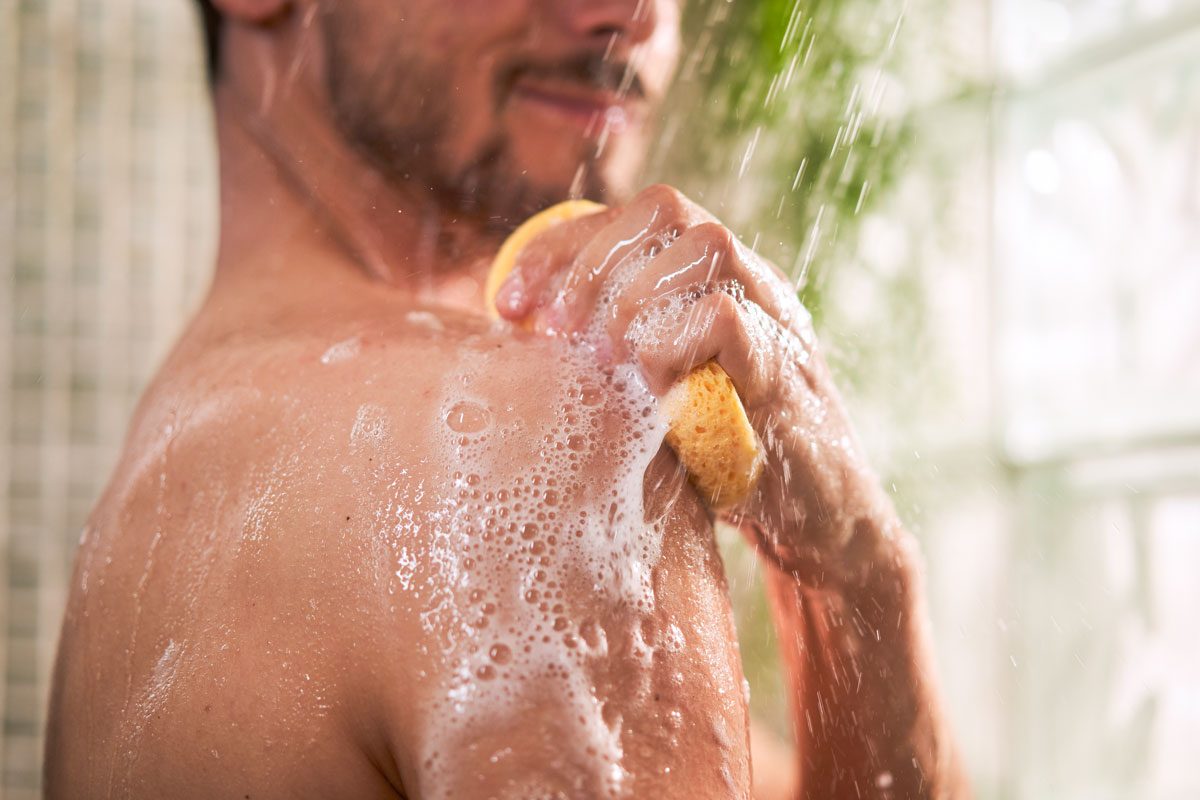
1. Shower regularly
When it comes to facial acne, dirty skin as a cause is a myth dermatologists want you to stop believing. While it’s recommended to wash your face twice a day, overwashing or using harsh cleansers is more likely to make acne worse.
But minimizing sweat, sebum, and dead skin cell buildup is one of the most important ways to help control chest acne, Dr. Massick says. Make sure to shower at least once daily, especially after sweating or working out.
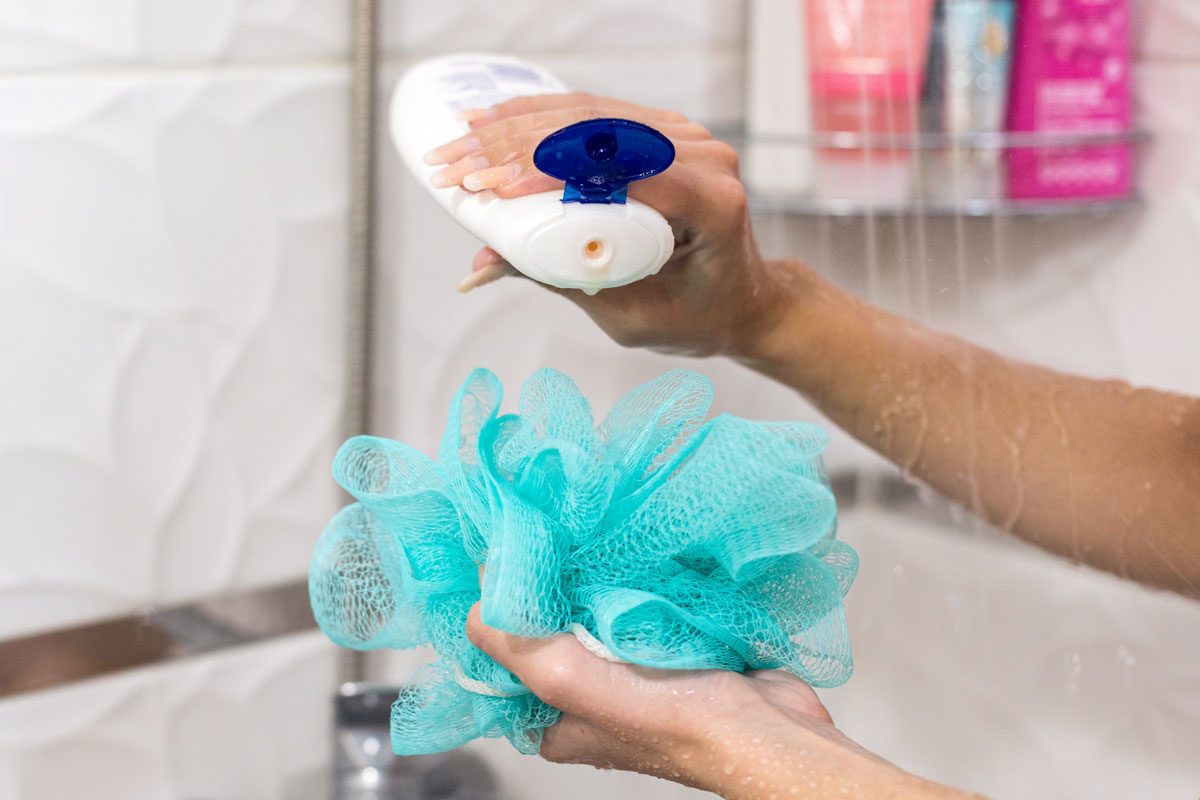
2. Try over-the-counter acne cleansers
Dr. Massick recommends trying out an anti-bacterial and anti-inflammatory body wash, such as one containing salicylic acid or benzoyl peroxide.
“Benzoyl peroxide can be a little more drying,” she says, so you’ll want to make sure you’re properly moisturizing after showering. It can also bleach your clothes (but not your skin), so be sure to rinse completely and use light-colored towels to avoid ruining any of your clothing.
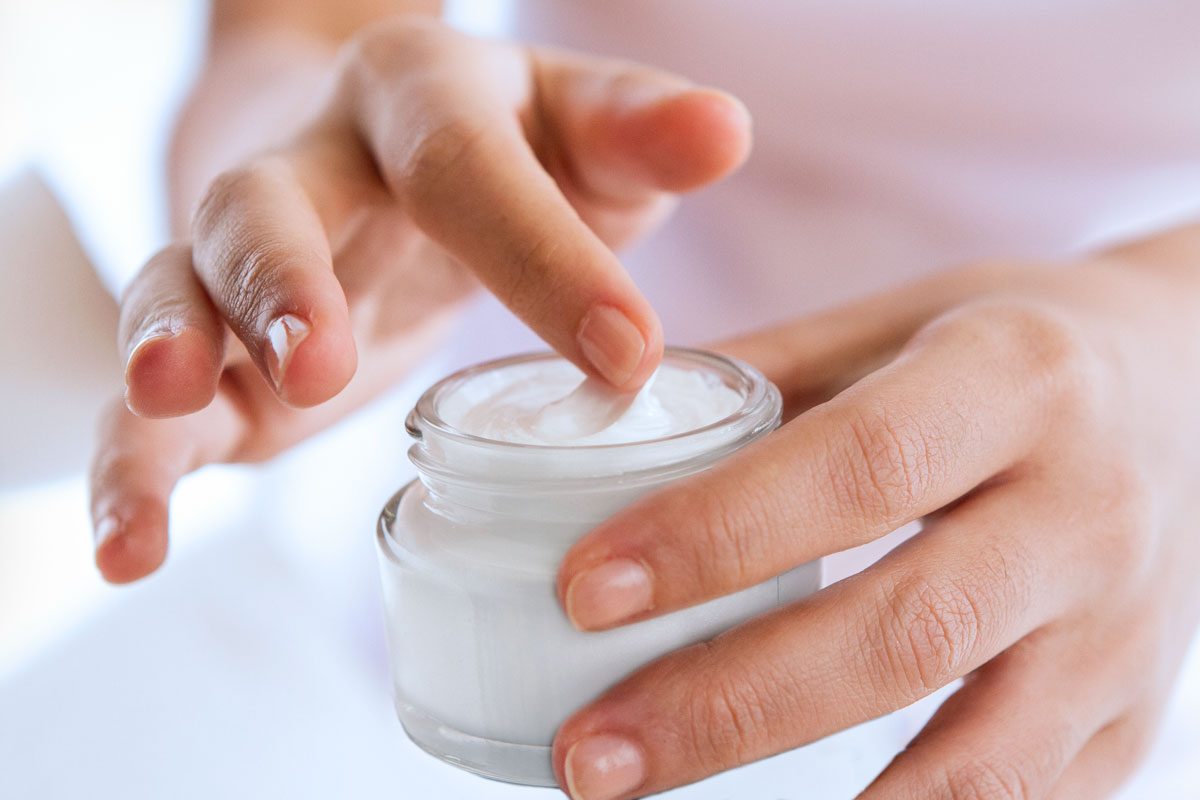
3. Use non-comedogenic, oil-free products
The term non-comedogenic means that a product is formulated without ingredients known to clog pores, Dr. Massick says. As skin oil is a major contributing factor to acne, you’ll want to look out for oil-free products as well, to prevent adding extra oil to the skin.
Using lotions or oils with essential oils, fragrance, or scents can also exacerbate chest acne, Dr. Massick adds.
This rule applies to any product you put on your skin, such as body cleansers, moisturizers, and sunscreen. But if you’re prone to acne on your chest, shoulders, or back, make sure that your shampoo and conditioner are non-comedogenic, too. In addition, dermatologists say it’s a good idea to cleanse your skin after washing and conditioning your hair to make sure you wash off any product residue left on your skin.
Dermatologists also advise to stay away from these 9 common skincare ingredients if your skin is breaking out.

4. Change your bedding weekly
Poor sleep is associated with a greater risk of acne breakouts, according to 2023 research published in Sleep and Breathing. But even if you get plenty of high-quality sleep, it won’t do you much good if you’re slipping into dirty sheets.
Every night, our sheets collect dead skin cells, bacteria, sweat, oil, and saliva—all of which can work to clog your pores while you’re sound asleep. If you have acne-prone skin, experts advise changing your sheets at least once a week (and it’s not a bad idea to shower before bed, too).
Harsh laundry detergents may irritate your skin, too, exacerbating breakouts. Similar to choosing your skincare products, look for mild, hypoallergenic laundry detergent that’s fragrance-free.

5. Choose the right workout clothing
Tight-fitting exercise tops and bras can trap sweat, moisture, and bacteria, particularly when you’re drenched in sweat, Dr. Massick says. “Choose moisture-wicking fabrics when exercising and stay cool as much as possible.”
Moisture-wicking means that the fabric is designed for two main purposes: It moves sweat away from your skin to the top layer of the fabric, and it dries quickly. Look for activewear made from breathable, moisture-wicking materials such as polyester, nylon, or bamboo. Then, remove sweaty workout clothes and bathe as soon as possible after exercising, Dr. Billero says.

6. Re-evaluate your supplements
Certain supplements are known to contribute to acne in some people, Dr. Billero says. Androgen supplements are a major culprit, which include any product that aims to increase testosterone in the body. Anabolic steroids are one example—and while they’re sometimes used in a medical setting to treat certain conditions, anabolic steroids are often misused by athletes and bodybuilders to enhance performance and build muscle mass, according to the Cleveland Clinic.
In fact, Dr. Massick recommends steering clear of any supplement marketing for bodybuilding and muscle growth: “Some can contain testosterone and be a big culprit for chest acne.” She adds, “The jury is still out on creatine and biotin.”
In addition to whey protein, research published in the Dermatology Online Journal found that high doses of vitamins B6 and B12 can contribute to or worsen acne—especially in women—as can iodine supplements, including kelp seaweed supplements.
That said, here are five natural supplements that may help clear up your acne.

7. Make some dietary tweaks
Aspects of your diet can be a potential trigger for chest acne, Dr. Massick says. In particular, she points to foods high in processed sugars, fatty or fried foods, and whole milk dairy products (though yogurt and cheese are generally fine, she says).
A 2022 review of research published in JAAD International explains that a diet high in dairy products and foods with a high glycemic index (GI) has been shown to affect the levels of hormones involved in acne development. High-GI foods include things like refined carbohydrates (such as white bread and many breakfast cereals), baked goods, packaged snacks, sugar-sweetened drinks, and starchy vegetables like potatoes.
Other research published in the American Journal of Clinical Dermatology in 2020 found strong evidence that incorporating more low-GI foods, such as fruits, vegetables, legumes, and whole grains, can help reduce acne. The research also shows that a greater intake of omega-3 fatty acids and probiotics may help prevent acne as well.
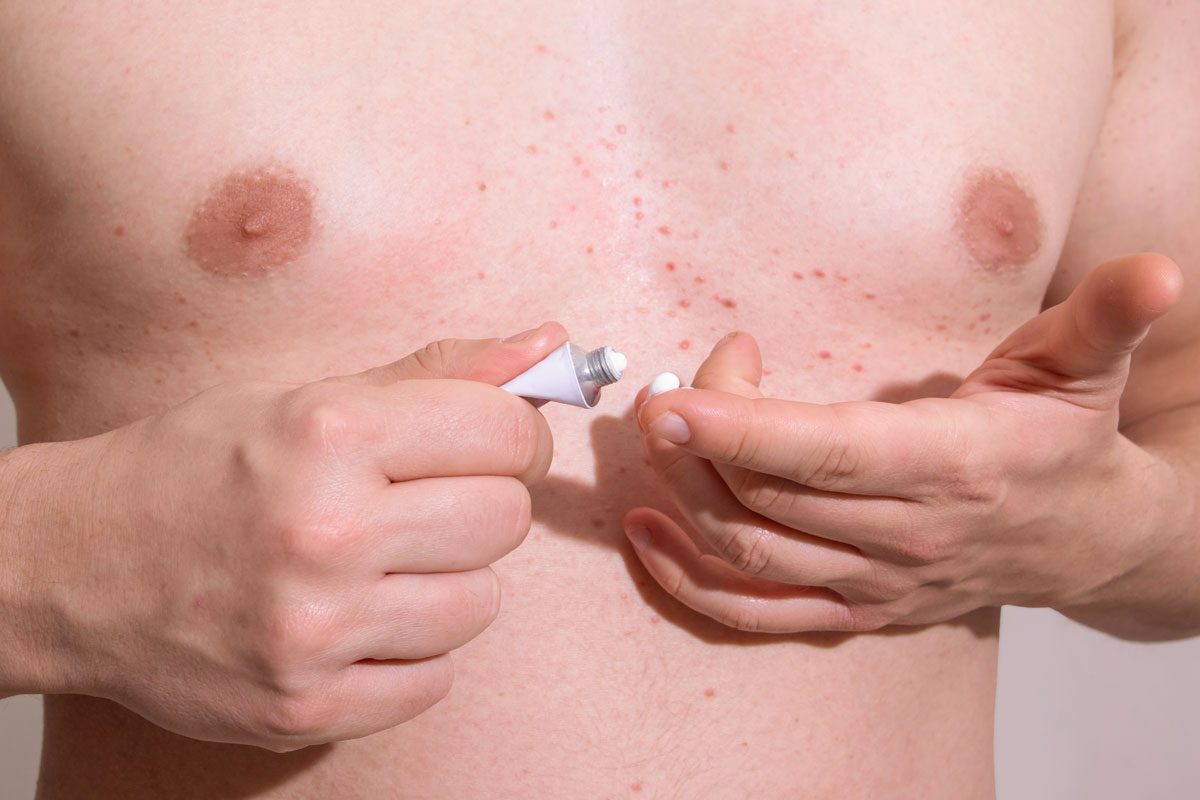
8. Try topical creams
If acne persists after addressing lifestyle factors, there are many great over-the-counter products for managing chest or truncal acne, Dr. Billero says. “Benzoyl peroxide cleanser, salicylic acid cleanser or serums, sulfur masks, and hypochlorous acid spray are great options,” she notes, adding, “I would recommend starting with one product at a time to reduce the risk of irritation and dryness. Trial it for a couple of months to see if there is any improvement.”
The Journal of Clinical Medicine research adds a few other popular skincare ingredients known to help manage chest acne:
- Glycolic acid
- Lactic acid
- Mandelic acid
- Retinoic acid
- Kojic acid
- Azelaic acid
- Jessner’s solution (a combination of lactic acid, salicylic acid, and resorcinol)
Again, don’t try all types of products at once—you’re more likely to dry out your skin and potentially make acne worse. If a trial-and-error process isn’t working, it’s worth seeing your dermatologist, who can diagnose what types of acne you’re dealing with and help direct you to the best combination of ingredients.
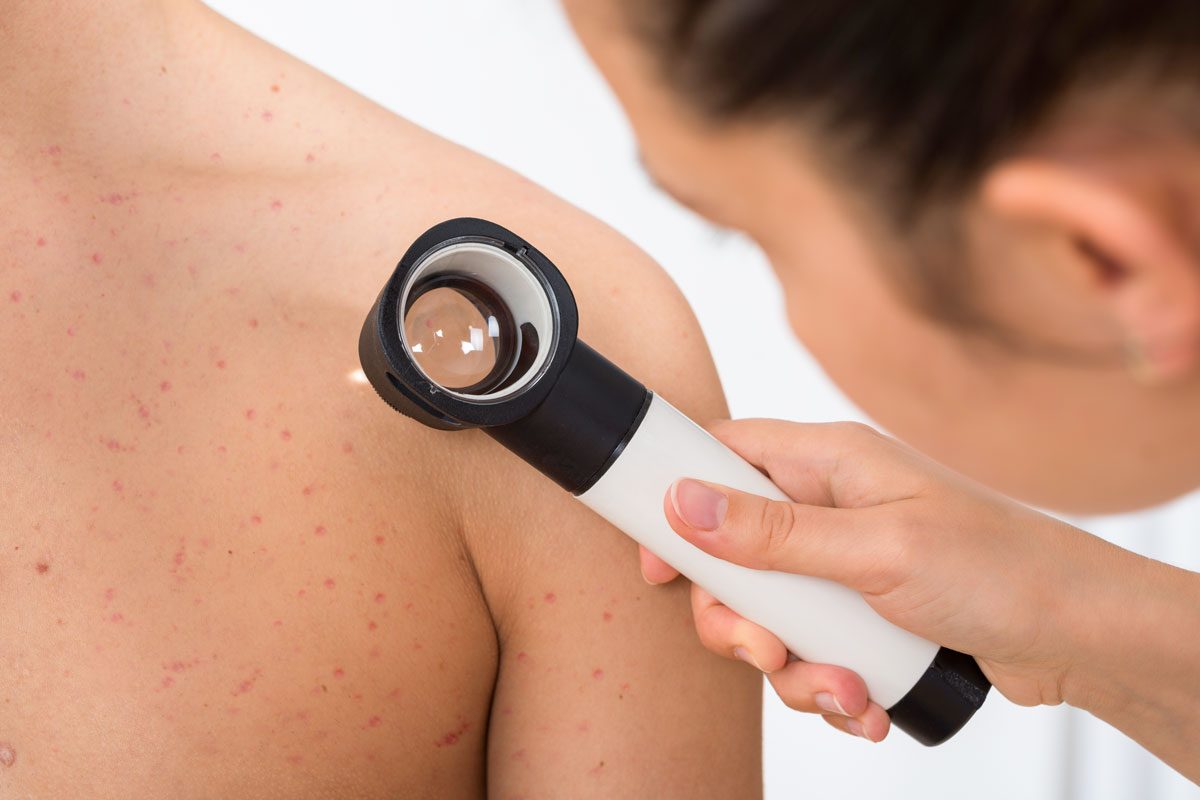
9. Schedule an in-office treatment
For chest acne that’s especially resistant to standard products, a dermatologist can apply a chemical peel with ingredients specifically formulated for the type(s) of acne you have—and that are stronger than what you can get over the counter.
Laser or light-based therapy is another option that’s been shown to be effective for stubborn acne. Among the various methods, photodynamic therapy (PDT) has the greatest evidence for managing chest acne, per the Journal of Clinical Medicine Research.

10. See your doctor for anti-acne medications
“Depending on the type of acne, we can prescribe topical and oral medications that would best treat the type of acne,” Dr. Billero says. “These include topical or oral antibiotics, topical or oral antifungals, topical or oral retinoids, or topical or oral anti-androgen medications.”
In some cases, hormone therapies, such as oral contraceptives or spironolactone, can also be effective in treating acne, according to the Journal of Clinical Medicine research. These hormone-based medications reduce sebum production in your skin, helping to clear up acne.
Due to adverse side effects, options like oral contraceptives or spironolactone are only available for women. However, anti-androgens, particularly a topical medication called clascoterone, is a hormonal therapy that can help treat acne in men (and women), according to 2025 research published in Dermatology and Therapy.
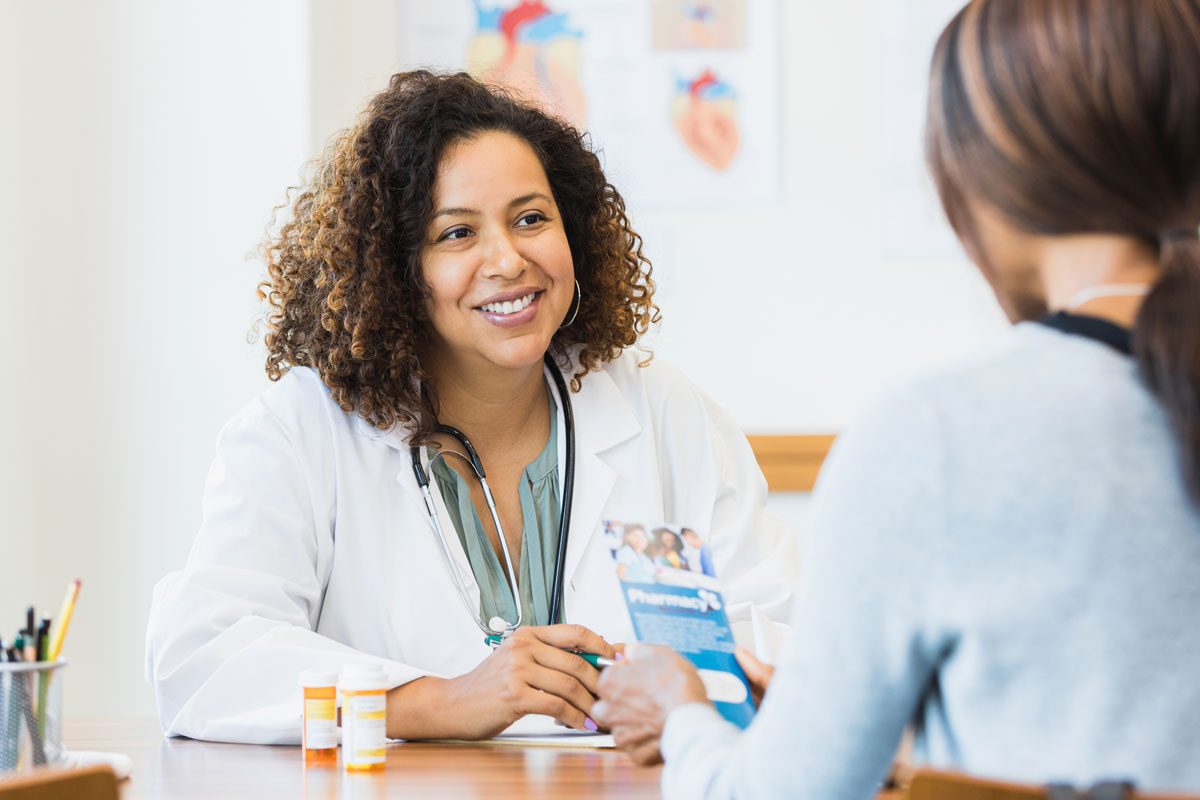
11. Talk to your doctor about medications you’re taking
Certain medications can contribute to acne formation. While you should never stop taking a medication on your own, your doctor may be able to offer an alternative that’s less likely to induce acne as a side effect. For instance, while many oral contraceptives can help reduce acne, certain forms of birth control—particularly progesterone-only contraceptives—can trigger breakouts, Dr. Billero says.
The Journal of Clinical Medicine research also says that chest acne can be a side effect of medications including:
- Glucocorticoids—a common type of medication used to treat conditions ranging from asthma and allergies to autoimmune diseases like rheumatoid arthritis
- Phenytoin—an anti-seizure medication
- Lithium—a medication used to treat certain mood disorders
- Drugs that contain halogens—these can include some medications that treat high blood pressure, liver damage, chronic kidney disease, and depression, among other conditions
When to see a doctor for chest acne
If you’ve tried various methods to get rid of chest acne and don’t see improvements in one to two months, it’s worth seeking the help of a dermatologist, Dr. Massick says. “Don’t wait if the acne is worsening, painful, with significant under-the-skin nodulocystic breakouts, or if you’re concerned about infection with redness, swelling, and pus/drainage.”
But there are some specific cases when you should head to the doctor’s office sooner than later:
- A condition called pityrosporum folliculitis is often confused with acne, but it’s a type of fungal infection in your hair follicles that causes small, uniform, itchy bumps across the skin. It won’t respond to typical acne treatments and requires antifungal medication, Dr. Massick says.
- If you have hormonal issues, such as irregular periods, polycystic ovary syndrome (PCOS), or are taking steroids, see your doctor for help managing acne, says Dr. Massick.
- Dr. Massick says that systemic conditions, such as hidradenitis suppurativa—an inflammatory condition that causes small, painful lumps under the skin—can lead to draining cysts and a high potential for scarring, and should be managed under the care of a medical professional.
- If you have a severe form of acne with deep, inflamed breakouts—known as nodulocystic acne—most OTC options won’t be able to control or reverse it, Dr. Massick says. “Dermatologists can help you manage your lifestyle, adjust your habits, and prescribe medications with safe, effective results.”
- You should also see a dermatologist if chest acne erupts out of the blue, if it is covering a large surface area of the chest or trunk, or if it is painful, bleeding, and/or draining, Dr. Billero adds.
For daily wellness updates, subscribe to The Healthy by Reader’s Digest newsletter and follow The Healthy on Facebook and Instagram. Keep reading:















